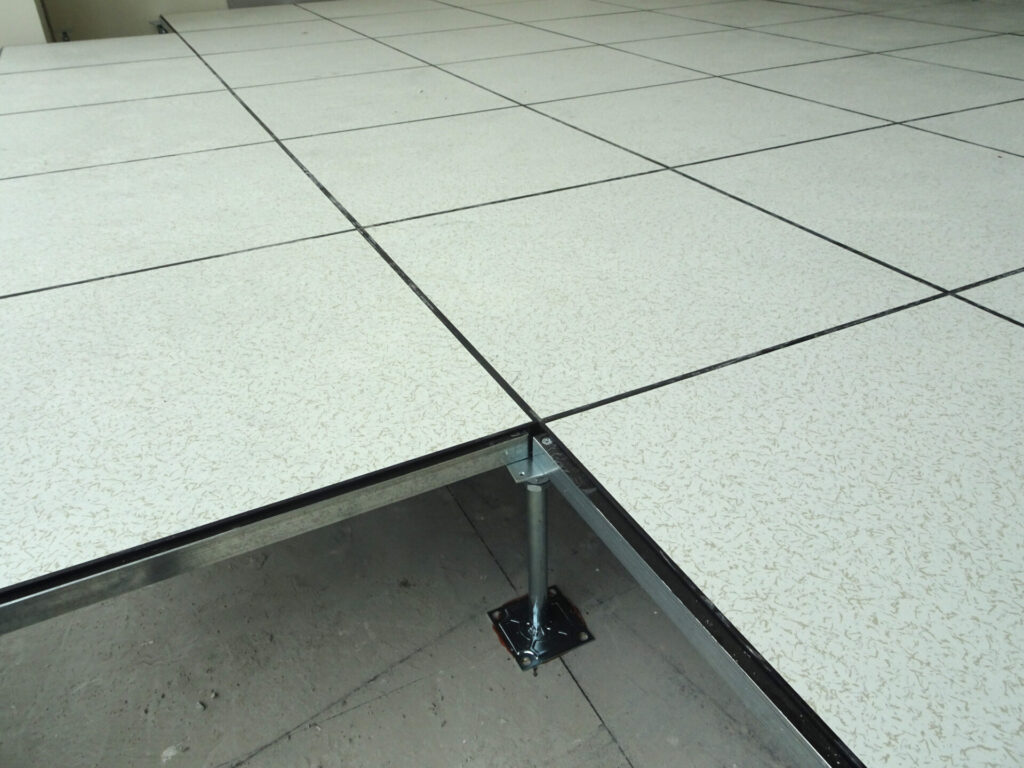In last month’s article, we discussed why it might be time to consider replacing your data, telecom, or other facility’s raised access flooring. While there are some great reasons to consider a replacement, including potential energy savings, reduced maintenance costs, and easier infrastructure upgrades, the most compelling reason is this:
A damaged raised floor system is dangerous. It’s hazardous to employees, equipment, facilities, and your bottom line.
Here are four general reasons why a damaged floor system can be hazardous for your company and why ensuring that your raised access floor is up to date is critical to providing your team with a safe workplace.

A Damaged Raised Floor Can Cause Employee or Contractor Injuries
Slips, trips, and falls are already among the most common causes of workplace injuries. Fall-related injuries overtook muscle injuries due to overexertion as the most common workplace injury in 2016.
There are countless potential causes for workplace slips, trips, and falls. Even the edge of a decorative area rug can be responsible for a nasty injury. A poorly maintained or damaged access floor system creates an even higher level of risk.
Trip Hazards
Even if no part of your raised flooring is visibly broken, components that are merely worn from use can be a hazard. As floor panels age, they invariably start to sag in the middle. This sag causes the edges of these panels to pop up and sit higher than the surrounding tiles. Even a tiny variation of 1/8″ or less can cause someone not expecting a change in the floor’s level to trip or stumble.
Additionally, warped panels can rock unexpectedly, causing even the most sure-footed person to at least momentarily lose their balance.
Fall Hazards
At the other end of the danger spectrum is the risk of a floor panel breaking or falling through as a person walks across it. While floor panels are rugged and designed to carry a considerable load, a few things can conspire to create an unsafe situation:
- Floor tiles that are excessively worn or were not adequately maintained can fail.
- Stringers not correctly secured or adequately maintained can break or shift out of position, allowing one or more floor tiles to collapse.
- Pedestals that are not installed correctly can fall or collapse, bringing down an entire flooring section.
A collapse of a single tile or a section of tile is dangerous under any circumstances. Even if the floor is only raised 6″ above the subfloor, that’s more than enough height to lead to sprained or broken feet, ankles, and knees. When the floor is suspended several feet above the subfloor, a collapse can lead to more severe injuries.
A Damaged Raised Floor Can Cause Significant Equipment Damage
Imagine taking one of your valuable servers out of its equipment rack, holding it 2-3 feet above a hard floor, and then dropping it. While we can’t say for sure what would happen, odds are pretty good that the results would be pretty bad.
Servers, computers, routers, and other data equipment are fragile. When a floor tile fails or the floor structure collapses, you can expect to replace every component in any cabinet or rack that falls through to the subfloor.
Of particular danger are repairs that have left a room using two different floor systems – an updated floor that is installed only in non-equipment areas leaves racks and cabinets floating on “islands” of old flooring. Without the structure of a matching flooring system interconnected together, these islands are weak spots in the floor that will eventually lead to equipment damage.
A Damaged Raised Floor Can Cause Damage to Your Facility
Obviously, when someone or something falls through the floor, it’s bad for the someone or something. But it’s also bad for whatever the someone or something lands on. Damage to your facility may be minimal if the collapse happens over an empty space. However, the secondary damage to your facility can be considerable if the failure occurs above an HVAC duct, a main power cable, or water/coolant lines.
A Damaged Raised Floor Can Cause Negative Bottom-Line Impacts
Even if nobody is hurt, no equipment falls to its doom, and your facility isn’t blacked out or flooded by a raised flooring collapse, it will cost you money, even if only in repair costs for the damaged floor. You’ll be looking at even greater expenses if anyone was injured, equipment was rendered unserviceable, or any damage was inflicted on the facility.
If you begin to see any of the symptoms we discussed in last month’s article, it indicates that your raised floor is no longer as safe as it should be, and you should be considering replacement. Replacing a damaged raised floor may be an expense, but not replacing it could turn out to be an even bigger expense.
Need a New or Replacement Access Floor? JLJ & Associates Can Replace Your Floor Without Downtime!
JLJ and Associates is Georgia’s choice for access flooring. Our proprietary technology can replace your access floor while your equipment remains online! Call us today to find out how we can develop a solution that works for you! 770-961-7600
Related Articles:

